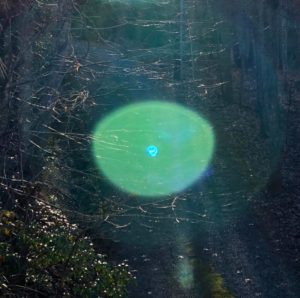
– Photo by Jan Ketchel
If we contemplate the oft-cited metaphor of an individual human life being but a drop of water in an ocean of its greater wholeness, we might come to another apt metaphor: Is the glass half empty or half full? Being half empty is the deflated perspective that a mere drop of water is so minuscule as to be essentially insignificant.
From this perspective it’s hard to imagine that anything we might do could possibly positively impact the greater world, especially in this time of such obvious great upheaval. A mere droplet of water could hardly reverse the tidal wave of energy impacting Earth’s many shores.
From the more optimistic glass half full perspective, we might appreciate the holographic perception of that drop of water as a fragment that in fact mirrors and contains the entire ocean. Transformations within that single droplet inevitably impact the entire world.
The challenge is to claim ownership for the entire world within the province of the self. Nothing that exists without does not exist within. On some level, in some form, we are, each of us, as individuals, also the world.
Outwardly, societies have struggled to create civilization—a humane interconnectedness that eliminates the extreme cruelty and brutality of barbarism. Regardless of a given civilization’s progress in actualizing its civilized intent, greed and self-interest remain part of the self and part of the world.
Wars, at their root, result from the breakthrough of these shadow energies, previously held in check by a civilized container. The explosive release of these powerful energies leads to great destruction of the Earth and human life. Postwar optimism and renewal of life become possible once the deployed energies of destruction are on the wane, and as good once again begins to assert itself.
The inefficiency of this war and peace cycle is obvious, particularly at a time when modern weaponry can destroy the Earth. Quite simply, humanity must develop a new technology to harmonize the bipolar energies within itself. Rather than simply repress and imprison its unwanted self, humanity must own and integrate all parts of itself.
This brings us back to that droplet of self we know ourselves to be in this life. Within that droplet is every person, every act we see perpetrated in the world. Firstly, can we own that behavior out there that we so disdain? We can believe that we would never do some of the things we see happening in the world, but can we own the fascination, rage, joy, contempt, or hatred we might be inwardly experiencing that vicariously activates and releases like energies in ourselves?
Own your shadow. Jung believed this to be the greatest challenge and necessary next step in human evolution. Carlos Castaneda left us the technology of suspending judgment of others to own our own shadow. When we judge, we put ourself above the person we are judging. This separation of self from other is actually a disowning of the part of ourself activated by the other’s behavior. When we suspend judgment, we are freed to face honestly all we discover in ourselves, good and bad.
The Buddhists highlight the technology of compassion to reconcile with the unwanted within the self. Every time we find ourselves triggered and enraged by the behavior of another, feel loving compassion for that human being in deep struggle with the forces within themselves. Use such moments as teaching moments, asking the self, “What am I supposed to learn from this experience?” In this manner, everything becomes personally meaningful and part of our own journey to reconciliation and wholeness.
This in no way means to deny the rage and hatred experienced at the barbarism on display, but to reach a feeling of deep compassion is to absorb and transmute those warring energies, creating deep acceptance of self and other. True love requires that we love all.
Our holographic droplet of water self that achieves both a suspension of judgment and compassion for the other is in such a state of advance that its greater wholeness, the ocean and humanity at large, can’t help but be changed by it, within and without. Do not doubt; this is the power of the humbly small.
Half full with compassion,
Chuck

